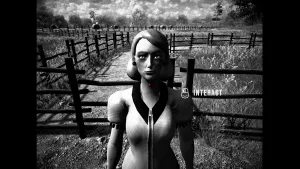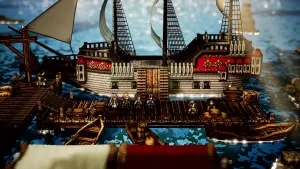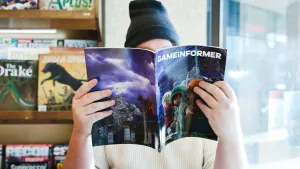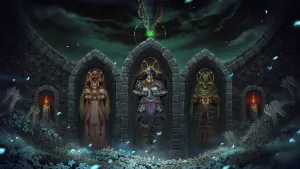Can't Look Away: The Evolution Of Modern First-Person Horror

A few years ago, fear and uncertainty surrounded the future of horror games. Nonstop action had infiltrated a genre long defined by gradually exploring morbid environments, managing scarce resources, and evading monstrous creatures. Resident Evil jumped into the cooperative-shooter camp with its fifth installment. Dead Space's sequels skewed more toward action than frights. Newer games in the Silent Hill series were released to noticeably mixed opinions. The genre had evolved with the times, and while many appreciated the improved controls and suspenseful combat, hardcore fans of traditional horror saw a pivot toward weaponized thrills and telegraphed scares. Many wondered if survival horror could accommodate both crowds.
Then in 2010, little-known Swedish developer Frictional Games released Amnesia: The Dark Descent. Here was a game that not only drove players to cower in the shadows from deformed monsters, but forced them to confront their fears through the immersive lens of a first-person perspective. Tasked with escaping a living shadow, they traversed Castle Brennenburg alone and unarmed. They collected lantern oil and tinderboxes to light their way, and slinked in the shadows to escape monsters. Lingering in darkness or catching sight of these roaming monstrosities drained an in-game Sanity meter, making visual disorientation a constant threat.
In the years since, developers have built a thriving first-person subgenre with games such as Outlast, Among the Sleep, and Alien: Isolation innovating horror gameplay to produce fresh scares. These mechanics – which expunged combat in favor of stealth – laid the subgenre’s foundations and pointed toward its promising (albeit challenging) future. Their origins, however, can be traced back long before players descended beneath the stone of Brennenburg.
Roots of Fear
You’re trapped in a maze. A ravenous Tyrannosaurus rex stalks the blocky, black-and-white passages. To survive, you must locate the only exit. “REX LIES IN WAIT,” warns a line of text. With a cautious keyboard tap, you take your first step. “HE IS HUNTING YOU,” the text now reads. The monster could lurk anywhere. You round a corner and receive a sudden warning. “REX HAS SEEN YOU.” You sprint and take a sharp turn – straight into a dead-end. There’s no escape. “REX IS BEHIND YOU.”
Developed for the Sinclair ZX81 home computer and released in 1982, 3D Monster Maze could very well be the earliest title to terrorize helpless players from a first-person perspective. Its namesake maze is bleak and claustrophobic, its monster relentless. You can’t fight back against the roaming T-rex, only sprint away with quick, panicked keystrokes. And yet, it’s difficult to pinpoint a direct chronology that links the vintage game to the genre’s most famous icons.

Though first person dominates the survival horror landscape today, the fixed camera angles of Alone in the Dark in 1992 and Resident Evil in 1996 originally defined the term as a third-person nightmare. But beyond Resident Evil’s sphere of influence, PC developers were experimenting with letting players gape at horrifying sights directly. Doom pitted a lone marine against hellish demons in a first-person shooter that sparked controversy with its grotesque gore in 1993. The following year, PC gamers faced System Shock’s deranged A.I. SHODAN and a space station crawling with hostile cyborgs and mutants. System Shock 2 built upon its predecessor’s success with exhaustive RPG mechanics and open-ended spaceship levels drenched in disturbing imagery. Defined by a cautious pace and meticulous scavenging, the atmospheric shooter inspired dread with the unsettling abominations that prowled the Von Braun. Its influence persists to this day, with many horror developers taking a similar approach to fleshing out their unsettling worlds.
But to find a close analogue to the evasive horror titles of today, one must look to a Korean PC title released in 2001. The similarities White Day: A Labyrinth Named School shared with modern first-person horror games are as eerie as its myriad spirits. When trying to return a lost diary to a girl he fancies, an unlucky student ended up trapped inside a school after dark. A psychotic janitor armed with a baseball bat patrolled the hallways, and malevolent ghosts haunted various nooks and crannies. Utterly defenseless, the student lit his way with matches and solved exploration-based puzzles to progress deeper into the school. Between its unpredictable enemies and unrelenting spooky ambience, the game knew how to catch people off guard.
Upon its release, White Day failed to find a ready audience. Though the game never officially left Korea to haunt other shores, it began to gain cult-classic status among hardcore horror enthusiasts thanks to an English-translated fan patch. Lunar Software founder Aaron Foster cites it as an inspiration for his team’s upcoming sci-fi indie horror game Routine, alongside the Alien movies and System Shock 2. “You could hear [the janitor’s] keys outsider doors, and you couldn't see what was there because the lens flare of his flashlight was so bright,” he says. “It was a really surprisingly intense and scary game for how primitive a lot of the art was, by this time anyway – and I was just blown away by it.”

A Popular Outbreak
A launch title for the Xbox 360, Condemned: Criminal Origins gave a new console generation an early serving of first-person fear in 2005. On the trail of an elusive serial killer, agent Ethan Thomas investigated derelict building and bludgeoned their psychotic inhabitants to death with pipes and other blunt objects. Cryostasis: Sleep of Reason also packed a fair share of action when it stranded players aboard a frozen Russian icebreaker in 2009. Though plagued by technical shortcomings, its pitiless Arctic setting and thought-provoking memory sequences highlighted the horror genre’s potential for interactive storytelling. Though both games armed their survivors with guns, they stepped away from pitching them as a go-to solution.
Their potential manifested again when Frictional Games first put down its roots in the horror genre in 2007. Trapped underground in a frigid Greenland mine, players used a flashlight and glow stick to explore Penumbra: Overture’s dank tunnels plagued by infected dogs, giant tunneling worms, and cave-dwelling spiders. The game also armed players with improvised weapons – a feature Frictional Games quickly ditched when working on its sequel. Dropping combat fundamentally transformed how players interacted with levels and responded to scary stimuli, says Frictional Games co-founder and creative director Thomas Grip.
“Even if you have the tiniest hammer… people are still like, ‘Ah, a weapon! I'm going to bash some mutant wolf skulls in,’" Grip says. Following the release of Penumbra: Black Plague and a puzzle-based expansion Penumbra: Requiem in 2008, the studio went on to land a massive hit with its next project, Amnesia: The Dark Descent, which introduced evasive non-combative horror to a wider audience.

Amnesia’s success not only opened up opportunities for its creators, but for other developers hoping to make their mark on the genre. Looming large among them was Red Barrels. Founded by veteran developers from Ubisoft and EA, the studio saw an untapped niche for hardcore scary games, says co-founder David Chateauneuf, whose resume includes Prince of Persian: The Sands of Time, Assassin’s Creed, and Splinter Cell: Conviction. “By watching and looking on the Internet, [we found] a bunch of players that were saying, ‘Well, there are no more real scary games. All those games are gone. They are all action, and it sucks.’”
Red Barrels answered this perceived shortage in 2013 with Outlast, a gory, twisted trip through a psychiatric hospital where otherworldly experiments have wreaked havoc. Building off the Penumbra and Amnesia formula, Chateauneuf says he wanted to give the playable character’s body a presence in Outlast’s horrific environment. A free-running approach to fleeing maniacal inmates, hurdling and clambering over obstacles and squeezing into narrow gaps, helped accomplish this goal. For a light source, the developer used a night-vision camera powered by scavenged batteries to take the place of a torch or flashlight to further make the game stand out.
Outlast had plenty of company within the indie scene. Slender: Eight Pages summoned the online-folklore figure Slender Man into a freeware computer game in 2012. The faceless teleporting apparition’s hauntings were expanded upon a year later in Slender: The Arrival. Wanting to move forward with an original project, Frictional Games handed off the next Amnesia game to developer The Chinese Room. Already known for minimal, deliberately paced exploration games like Dear Esther, the team released the narrative-oriented Amnesia: A Machine for Pigs in 2013. Norwegian developer Krillbite Studio harkened back to childhood traumas with Among the Sleep in 2014, which saw a toddler crawl his way through surreal ordeals. Together, these titles represent not only the diversity of first-person horror titles that work within Amnesia: The Dark Descent’s parameters, but their ability to succeed despite lower-than-average budgets.
For some developers, like Thomas Grip, the scope of first-person games better matched their resources at the time. A self-described horror addict, he adopted the perspective when he started work on a Silent-Hill inspired project called Unbirth in 2001. The ease of not having to worry about modeling a third-person view of the player continued into the early days of Frictional Games. “If I had unlimited resources when we started making Penumbra, we might have made it third person,” he says, explaining that two of his favorite games at the time, Silent Hill and Silent Hill 2, used that viewpoint.
Other indie-horror developers have found the model a good fit, due to its greater reliance on building atmospheric environments, rather than complicated programming and elaborate animations. “Without the need to have a character in view, doing all the animations for that, it was a much easier workload,” says Foster, who began work on his own science-fiction exploration project in 2011. “But I think first-person has always appealed to me, in a way, because I feel like the focus is much more on the environment, rather than your character.”

Now working on his Steam Greenlighted title Routine, set in a low-tech, retro 1980s vision of a future moon outpost, Foster says player immersion remains the perspective’s main strength. These benefits have helped spark a first-person exploration boom beyond the realm of macabre asylums and gothic castles. The outpouring includes Fulllbright’s interactive house-exploration adventure, Gone Home, and The Chinese Room’s latest outing, Everybody’s Gone to Rapture. Upcoming titles such as the wilderness mystery Firewatch and the space station-bound Tacoma continue to prove you don’t need scares to tap into the strengths of non-combative first person gameplay. Meanwhile, the immense popularity of Five Nights at Freddy’s has bolstered the perspective’s credentials among gamers who like a good scare. Its focus on fending off monster attacks using security camera footage gives it a unique identity.

Indie Horror Goes Big Budget
In recent years, larger studios have also dived into the subgenre. Developed by the Creative Assembly, Alien: Isolation grabbed attention in 2014 with a reactive Xenomorph that hunted down its human prey with unpredictable craftiness. Creative director Alistair Hope originally pitched the game to SEGA and Twentieth Century Fox as a recreation of the authentic, cat-and-mouse allure of the first Alien film, taking marines and pulse rifles out of the picture. Instead, Amanda Ripley relied on flashbangs, flamethrowers, and other marginally effective weapons to distract and drive off the alien temporarily.
“It felt like this was a risk, because we weren't taking the path of least resistance, which probably was to make a game about shooting aliens,” Hope says. Though at one point his team had explored doing the title in third-person, first person eventually won out. “It was okay. It would have been a valid game. But it was a completely different experience. In first person you have this complete different relationship with the world and importantly with the alien – [it’s] not hunting the character. It's hunting you. When you look around the edge of a box, [you’re] looking around the edge. You're peeking – not your character.”
On the other side of the success spectrum from Alien: Isolation sits the 2015 cancellation of Silent Hills. The planned collaboration between Hideo Kojima and film director Guillermo del Toro (Pan’s Labyrinth, The Devil’s Backbone) demonstrated that horror-game development can be fraught with uncertainty. Cancelling the project brought about an online outcry from a passionate horror community, which had dedicated fan theories and videos to Silent Hill’s critically praised demo, P.T. Inspiration from it has even seeped into Allison Road, an upcoming indie tribute to the slow-burning terror of old-school horror. Meanwhile, P.T. and has become a sought-after digital remnant of what could have been.
Like Konami backing away from Silent Hills, other large publishers have passed on ambitious scare-based projects. Before founding Red Barrels, Chateauneuf and fellow Red Barrels founder Philippe Morin had wanted to make a horror game while still working at Ubisoft. They pitched a concept for a Wii title that used the console’s remote and nunchuk controllers to simulate the left and right hands. The idea didn’t gain traction at the massive publisher, says Chateauneuf, who thinks the genre might not be a right fit for big companies with AAA budgets, due partly to its niche audience. It took positive buzz surrounding Outlast to convince some wary developers to take a chance with his young company, Chateauneuf says, and today Red Barrels is expanding its team for Outlast 2, which it aims to deliver with a bigger scope.
Future Frights
In September, Frictional Games unleashed Soma, a horror game which sought to explore themes of identity, consciousness, and humanity. Within the underwater PATHOS-II facility, the game’s everyman protagonist Simon struggles against isolation, gut-wrenching choices, and the tangled mechanisms of an unfathomable A.I. Like its predecessor, Soma packed plenty of scares. But the philosophical questions raised by its story received greater attention during development, says Grip.
“We wanted to bring forth a certain existential dread in the players,” he says. “That was our main goal from the very get go. We even thought about having versions of Soma where there was no actual [threat] — that wasn't a normal horror game in the sense that it ended up being.”

Whether fabricated by a tight-knit indie team or assembled at a major studio, exploratory horror games face a challenge engineering new forms of fear. Though critics uniformly praised Soma, many players found the monster encounters hit-and-miss, Grips says, due largely to how familiar they felt. Still, he doesn’t see the subgenre going away, adding that the studio is coming up with ideas to take it forward. “It's some stuff we explored in SOMA but not to a big extent, and I think seeing the reaction has been very good. We know what to make next. We want to make it past this sneak, wait mechanic. I hope that other people are working on it too.”
For Outlast 2, Chateauneuf hopes to stress interacting with the in-game environment and avoid artificial puzzles or objectives. “We had that in the first Outlast, like find the three fuses to make the elevator work again,” he says. “Sometimes it becomes repetitive, and the player feels like it's really a game and not really an experience. So we're trying to tackle that and make it more believable.”
Because horror depends on what people see and sense, virtual reality has the potential to change how it’s experienced in games. Fresh out of a university program in Scotland, a group of classmates formed Team Junkfish with the intent to tackle replayable horror and virtual reality for their first project, says audio director Jaime Cross. Along with roguelike elements like permadeath that encourage players to puzzle their way through Monstrum’s procedurally generated ship, Oculus Rift support allows an extra layer of immersion.
So far, Cross says Team Junkfish has managed to temper real-world sea sickness some players could get from exploring the game’s derelict ship through a VR headset. Navigation issues, however, remain a concern. “As far as first-person games go, some people are still a little bit wary about their character avatars moving but they themselves aren't moving,” he says. “Everybody seems to have their own solution to it, but there's no golden rule that you should follow beyond, ‘Don't make people sick.’"

Many developers have taken up that challenge. Lilith Ltd. plans to use VR to add an extra level of discomfort to Allison Road. Brave souls will be able to walk haunted hallways and wander into a foggy swamp without the comfort zone that usually separates their eyes from the horror that unfolds onscreen. Other projects seeking to create intense VR ordeals include Narcosis, which asks players to live through the slow death of a miner submerged within a flooded research station. And while not strictly based in terror, Adr1ft will simulate oxygen-deprived panic when it transports players to a devastated space station drifting in Earth’s orbit.
Deeper Into Madness
Unadulterated, virtual terror has found a new lease on life in recent years. Though gunning down zombies will always appeal to a wide audience. Outlast, Alien: Isolation, Soma, and titles like them show that many players don’t mind being dragged into virtual nightmares. Jump scares alone won’t keep the subgenre alive, but if the future slate of first-person horror games proves anything, it’s that there’s always something new and frightening lurking in the shadows.
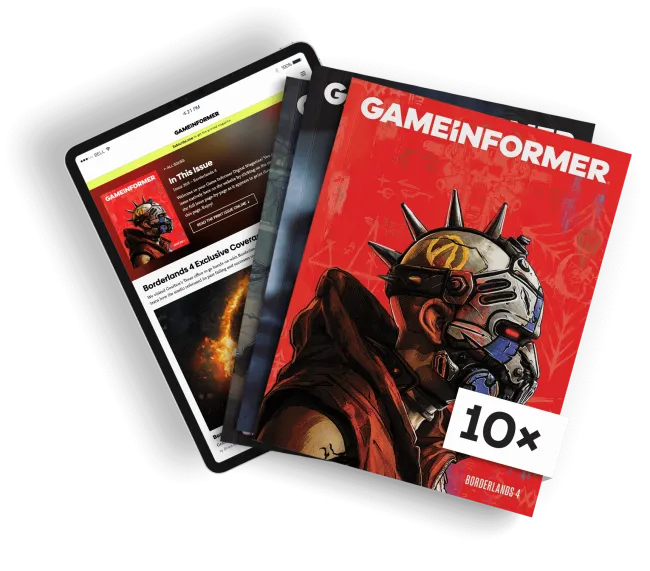
Get the Game Informer Print Edition!
Explore your favorite games in premium print format, delivered to your door.
- 10 issues per year
- Only $4.80 per issue
- Full digital magazine archive access
- Since 1991

